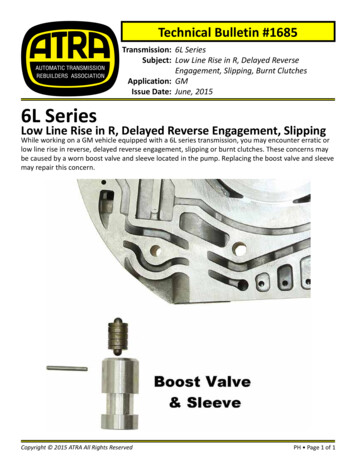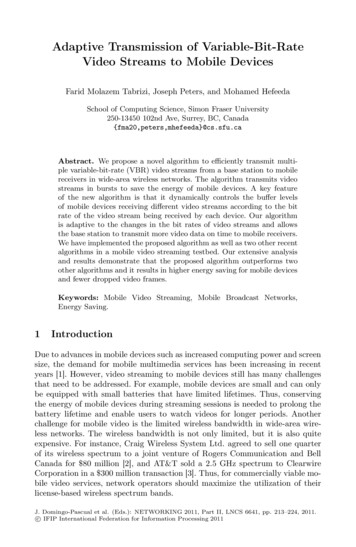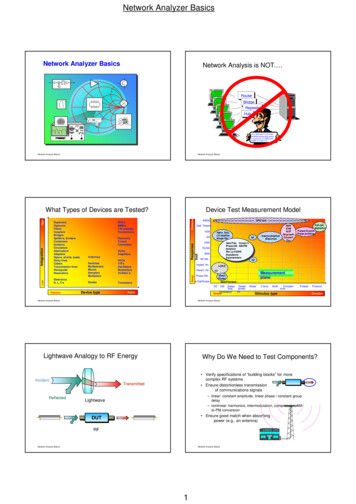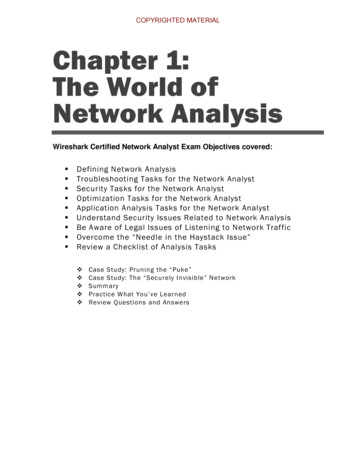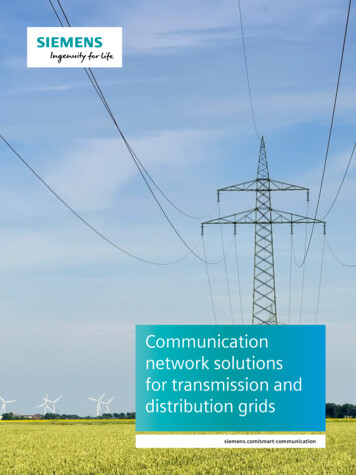
Transcription
Communicationnetwork solutionsfor transmission anddistribution gridssiemens.com/smart-communication
Communications solutionsare manifold – but we put itall togetherA secure, reliable, and economical power supply is closelylinked to a fast, efficient, and dependable communicationsinfrastructure. The planning and implementation ofcommunications networks require the same attention asthe installation of the power supply systems themselves.New challenges for energy networks As a result of the deregulation of the energy markets,the separation of the vertically integrated structures ofthe past, and the sharp increase in decentralized powergeneration, the reliable management of power supplysystems is increasingly challenging. This developmentgoes hand in hand with the rapid growth in the demandfor communications. This is not just a question of higherbandwidths but also of communications requirements fornew energy applications, including meter data management, distribution automation, and demand response,to name just a few examples. At the same time, energynetwork components like ring main units, distributedenergy re sources, virtual power plants, microgrids, publiccharging, energy storage, and private households needto be integrated into the power utilities’ communicationsinfra structure for smart grids.2Evolution of communications technology In a parallel process, communications technology hascontinued to develop rapidly over the past few years,and Ethernet has become the established standard inthe power supply sector.International communications standards like IEC 61850 willfurther simplify the exchange of data between differentcommunications partners.Migration to a smart-grid communi cations network This means that the power utilities’ mostly heterogeneouscommunications networks, with their gaps in coverage andbandwidth, need to be migrated to a smart-grid communications infrastructure. That will provide IP/Ethernet connectivity between most components. The gradual migration ofmost conventional communications interfaces and productstoward TCP/IP-based networks and the extension ofnetwork access down to the consumer level are thereforean important task for decision makers at power supplycompanies. To meet these challenges, a team-orientedand interdepartmental planning of migration concepts isrequired.
GassupplierGas stationGast transport„Power to value“(gas, liquid, chem.)BiomassNetwork controlcenterEnergyPumStoragesolutionsOnshore-wind farmElectric vehicleinfrastructureLarge scalePV torBuilding, data center- Nanogrid- DC-gridSubstationFossil power plantFossil power plantD ies elgeneratorMicrogridOns horeWindOnshore-wind ngThermalstoragePumped hydroGas stationPrivate wind orsolarHeater, ChillerHeat StationCombined(cooling)heat and powerGas storageOffshore-windfarmGas distributionGassupplierSmart buildingandthermal atGasCooling/heatSiemens offers complete communication network solutions to build a Smart Grid for power utilitiesWe offer a tailored solutionFor these communications requirements, Siemens offerscustomized and rugged communications network solutionsfor fiber-optic, power line, and wireless infrastructuresbased on the accepted standards of the energy industry.Naturally, this also includes a full range of services, fromcommunications analysis to the operation of the entiresystem.Your advantages at a glance: We offer tailored turnkey solutions for building apower utility communications network. We shape the future in terms of technology,standards, and solutions. Our customers benefit from Siemens’ securityexpertise. We offer customized after-sales services. We provide financing models. Our customers benefit from Siemens’ globalpresence and long experience in the utility industry.3
Customer-specific communi cations solutions requiredThere is a lot to do – on the journey to the grid of the future.Telecommunication for utilities has a long history in thetransmission level of the power supply system and Siemenswas one of the first suppliers of communication systems forpower utilities. Since the early 1930s Siemens has deliveredpower line carrier equipment for high-voltage systems. Intoday’s transmission systems, almost all substations aremonitored and controlled online by Energy ManagementSystems (EMS). The main transmission lines are usuallyequipped with fiber-optic cables, mostly integrated in theearth (ground) wires (OPGW: Optical Ground Wire) and thesubstations are accessible via broadband communicationsystems. The two proven and optimal communicationtechnologies for application-specific needs are Synchronous Digital Hierarchy (SDH) and Multi-Protocol LabelSwitching (MPLS) solutions. Fiber-optic cables are usedwhenever it is cost-efficient. In the remote ends of thepower transmission system, however, where the installation of fiber-optic cables or wireless solutions is noteconomical, substations are connected via digital highvoltage power line carrier systems.4The situation in the distribution grid is quite different.Whereas subtransmission and primary substations areequipped with digital communication as well, the communication infrastructure at lower distribution levels is veryweak. In most countries, less than 10 % of transformersubstations and ring-main units (RMU) are monitored andcontrolled from remote. The rapid increase in distributedenergy resources today is impairing the power quality ofthe distribution network. That is why system operatorsneed to be able to respond quickly in critical situations. Aprerequisite for this is the integration of the key ring-mainunits as well as the volatile decentralized wind and solargeneration into the energy management system, and thusinto the communication network of the power utilities.Because the local environment differs widely, it is crucialthat the right mix of the various communication technologies is deployed. This mix will need to be exactly tailored tothe utilities’ needs and the availability of the necessaryinfrastructure and resources (e.g., availability of fiber-opticcables, frequency spectrum for wireless technologies, orquality and length of the power cables for broadbandpower line carrier).
Medium voltageFiber opticsBPLCWiMAX / LTEBB meshPublicCellularetc.380 kV–500 kVGenerationLow voltageHV substation110 kV–230 kVHV substation400 V400 VRMUBuilding400 V6 kV–22 kVRMU400 VFiber-optic solutionsare the best choicefor all communicationneedsBroadband power linecarrier for LV to MVapplications usingthe existingpowerlineWiMAX / LTE solutionsfor RMU backhauland prosumerapplicationsMV substationPublic chargingfor e-carsCold storeHV substation30 kV–132 kVWind onshoreMV substationRMU withmeter dataconcentratorPLCBPLCRF Mesh /LTEPublicCellularetc.Rugged switches androuters that complywith energy industrystandardsHV substationWind offshoreEnd-to-end securityNetwork management systemFiber optics(SDH, WDM,MPLS )Power linecarrierMicrowaveetc.High voltageCommunicationsolutionsRMUWireless meshsolutions fromconsumer accessto RMU backhaulapplicationCyber security forthe operationof a secure networkMeterMeterMeterHomes(smart meter with PLC)MeterMeterHomes (smart meterwith wireless connection)Smart homes withenergy gatewayDistributedenergy resourcesBuild, care andprofessionalservicesCommunication network solutions for Smart GridsIn the consumer access area, the communication needs arerising rapidly as well. The following Smart Grid applicationsrequest a bidirectional communication infrastructure downto consumer premises, or to the loads. Exchange of conventional meters with smart meters,which provide bidirectional communications connectionsbetween the consumer and energy applications (e.g.,meter data management, marketplace, etc.). Management of consumers’ energy consumption, usingprice signals as a response to the steadily changingenergy supply of large distributed producers. If a large number of small energy resources are involved,the power quality of the low-voltage system must bemonitored, because the flow of current can changedirections when feed conditions are favorable.The selection of a communication solution depends on thecustomer’s requirements. If only meter data and pricesignals are to be transmitted, narrowband systems such asnarrowband power line carriers or GPRS modems aresufficient. For smart homes in which power generation andcontrollable loads (e.g., appliances) or e-car chargingstations are to be managed, broadband communicationsystems such as fiber-optic cables, power line carriers orwireless solutions (e.g., LTE) are necessary.For these complex communication requirements, Siemensoffers tailored ruggedized communication network solutions for fiber optic, power line or wireless infrastructures,based on the standards of the energy industry. Naturally,this also includes a full range of services, from communication analysis to the operation of the entire solution.5
Distributionnetworks6
Solutions for distribution grids(backhaul / access communication)In the past, electricity was mainly produced by bulkgeneration at central locations, and distributed to consumers via the distribution systems. Energy demand peaks(e.g., at midday) were well known and balanced out byreserve capacity of central power plants. It was thereforeusually not necessary to specially control the lower-leveldistribution networks, or even to integrate the consumersinto the grid monitoring system.Buildings account for 40 % of the world’s energy consumption and 20 % of total CO2 emissions. Therefore, smartbuildings also play a central role in the Smart Grid as theyprovide a huge potential for energy efficiency. Activelyinfluencing their consumption and generation, smartbuildings support the system stability and allow generatorsto consider other options before adding new generationfacilities.Ever since renewable energy has been significantly expanded, electricity is being fed into both the medium-voltageand low-voltage systems, depending on changing externalconditions (e.g., weather, time of day, etc.). These fluctuating energy resources can severely impair the stability of thedistribution grids.One of the key challenges of a Smart Grid therefore isquickly balancing out the energy supply and energyconsumption in the distribution system.Typical power distribution network integratingring-main units, consumers, prosumers, distributedenergy resources, etc.CommunicationsinfrastructureApplicationsWind onshoreCold storeMV substationVirtual Power PlantMicro Grid ControllerDistributionAutomationCondition MonitoringPublic chargingBuildingfor e-cars6 kV–22 kVMarketplaceDemand ResponseManagement SystemRMU withmeter dataconcentratorAsset ManagementMeter DataManagement400 VLow voltage(Access)Fiber opticsPLCWireless meshGSM / UMTS / LTEDSL, router, switchMedium voltage(Backhaul)MV substationFiber optics /SHD / MPLS-TPPLCEnterprise-WiMAX / LTEWireless meshGPRS / UMTS / LTERouter, switchUHF EvolutionControl Center(EMS / DMS)MeterMeterMeterHomes(smart meter with PLC)400 VMeterRMU400 VRMU400 VRMUBilling / Call CenterE-Car Operation Centeretc.MeterHomes (smart meterSmart homes withwith wireless connection) energy gatewayDistributedenergy resources7
New challenges for the operationof distribution gridsCommunication infrastructures for backhaul and access networksA prerequisite for implementing asolution for this demand is monitoringand managing as many components ofa power supply system as possible allthe way to the consumer. The basisfor this is a reliable communicationinfrastructure. For medium-voltage,at least the following system components must be integrated into a SmartGrid and managed: The key ring-main units All large distributed producers (solar /wind farms, biogas / hydroelectricpower plants, etc.) Large buildings, campuses, refrigerated warehouses, etc.For low-voltage, primarily householdsand small producers of renewableenergy are involved.With respect to their role in the powersupply system, consumers can bedivided into two groups: “Standard consumers”, who havesmart meters and optimize theirelectricity costs via ongoing pricesignals depending on supply anddemand “Prosumers” (prosumer producer consumer), who can feed surplusenergy into the power grid – such assolar power or energy generated bycombined heat and power systems(CHP); many can also intermediatelystore energy using possibilities suchas night storage heaters or e-cars.While the communication requirements for standard consumers areconcentrated on smart meteringincluding price signals, time-criticalcontrol signals and power quality datamust also be transmitted for prosumers. Therefore, in addition to smartmeters, prosumers have energy8gateways, which process and forwardthese control signals accordingly.The young history of Smart Grids hasalready shown that utilities do notimplement it as a whole from thescratch. They usually start with smartmetering projects with later extensions of Smart Grid applications.Already with the first roll-out, thedesign of the communication infrastructure has to consider the growingrequirements for these extensions.After a large deployment of meteringinfrastructure in the first step, it is notacceptable to replace the communication network a few years later becausethe requirements for the next subsetsof Smart Grid applications cannot bemet anymore.Communications infrastructures forall conditionsThe communication infrastructure inthe medium-voltage and low-voltagedistribution systems is usually heterogeneous, and the suitable technologies depend to a large extent on thelocal topology (large city, rural region,distances, etc.). It must therefore bespecifically tailored for each customer.In general, the following communication technologies are available: Fiber-optic or copper communicationcables are the best option, if present Power line carrier systems formedium-voltage and low-voltagenetworks Setup of own private wirelessnetworks (e.g., wireless mesh,private Enterprise-WiMAX / LTE, orUHF Evolution), when spectrum isavailable at reasonable prices orlocal regulations allow for it. Public wireless networks, dependingon the installation for narrowbandcommunication in the kbps range(e.g., GPRS), or in the Mbps range(e.g., LTE). Attractive machine-tomachine (M2M) data tariffs androbustcommunication in case ofpower outages are key ingredients tomake this communication channel aviable option.Depending on the applications beinginstalled inside the RMU, an Ethernetswitch / router might be needed inorder to concentrate the flow ofcommunications. These data concentrators can be implemented as customized solutions or integrated, forexample, in the RTU (remote terminalunit). To meet these requirements,Siemens offers a full range of allabove-mentioned communicationtechnologies including ruggedswitches and routers that complywith energy industry standards.
Fiber opticsEnergy lineEnergy line with PLC communicationMV substationPublic chargingfor e-carsCold storeMVBPL/PLCMV substationMVBPL/PLCMVBPL/PLCMVBPL/PLCMV substation6 kV–22 kVRMU withmeter dataconcentratorMeterCold storeMV substationPublic chargingBuildingfor e-carsRMU withmeter dataconcentrator400 VMVBPL/PLC6 kV - 22 kVMVBPL/PLCMVBPL/PLCRMU400 V400 VLVBPLMeter400 VMeterMeterHomes(smart meter with PLC)400 VMeterRMU400 VRMU400 VRMUSmart homeswith energygatewayDistributedenergy resourcesMeterMeterMVBPL/PLCRMULVBPL400 VLVBPLLVBPLRMULVBPLMeterHomesHomes (smart meterSmart homes with(smart meter with PLC) with wireless connection) energy gatewayEnergy lineMeterHomes (smartmeter with wirelessconnection)MeterLVBPLDistributedenergy resourcesMV Energy line with PLC communicationLV Energy line with PLC communicationFiber-optic infrastructure for distribution networkPower line carrier communication solutions for distribution networksFiber opticsPower line carrier solutionsThe best choice for all communications needsFiber optics is the best transmission medium for mediumand low-voltage applications because it is robust and notsusceptible to electromagnetic disturbances or capacityconstraints. That‘s why grid operators who choose thistechnology will be well prepared when their communications needs multiply in the future. Fiber-optic cables arelaid underground to connect indivi dual substations. Thiswork is associated with heavy civil works, and thereforewith great expense. However, when new power cables areinstalled the cost-benefit analysis paints a clear picture.Fiber-optic cables should generally be the first choice inthis case.For low- to medium-voltage applications,using the existing power lineStandards-based power line carrier solutions provide anattractive communication channel for all applications inmedium-voltage and low-voltage Smart Grid scenarios.They use the utility-owned infrastructure in the distributionnetwork, and provide a reliable and affordable communications channel. Therefore, PLC solutions are especially usefulfor connecting elements in grids, where no other reliablecommunication channel is available. They transform theDSOs assets into a highly capable Smart Grid communication infrastructure. With its throughput, low latency andhigh reliability, PLC solutions serve for distribution automation applications as well as for backhauling data frommetering applications in the medium-voltage grid.Benefits in detail: At the core of a variety of communications systems, frompassive optical networks (PON) to Ethernet and SDH Durable, insusceptible to electromagnetic disturbances Practically unlimited transmission capacityAs with every communication technology, the transmissionrange and bandwidth provided by the PLC solution dependson the quality of the used transmission medium. In case ofthe transmission over power lines, type and age of thepower cable as well as the number of joints have an impacton the achievable results. Consequently, a PLC networkneeds to be engineered and planned correctly to providemaximum performance.Benefits of power line communication solutions: They transform the utility-owned infrastructure intoa highly capable communication network. They are especially useful for connecting all elements inthe grid where there are no other reliable communications media available. They provide a communication solution for all MVpower grids.9
CommunicationEnergy lineEnergy line withPLC communicationMVsubstationMVsubstationMV substationMV substation6 kV–22 kV6 kV–22 kVService carRMU withmeter dataconcentrator400 V 400 VMeterCommunicationEnergy lineEnergy line withPLC communicationMeterMeterMeterRMU400 VRMU400 VRMURMU withmeter dataconcentrator400 V 400 V400 VRMU400 VRMUMeterMeterHomes(smart meter with PLC)RMUHomes (smartmeter withwireless connection)Smart homeswith energygatewayDistributedenergy resourcesMeterMeterMeterHomes(smart meter with PLC)MeterHomes (smartmeter withwireless connection)Smart homeswith energygatewayDistributedenergy resourcesEnterprise-WiMAX / LTE solution for distribution networksWireless mesh networkEnterprise-WiMAX / LTEWireless meshThe main application area for private WiMAX / LTE systems,specifically tailored to the needs of enterprises in verticalmarkets, is backhauling of RMUs, data concentrators orDistributed Energy Resources (DER). Single prosumers couldtechnically be served, but this is economically reasonableonly in selected cases. WiMAX (Worldwide Interoperabilityfor Microwave Access) is a standards-based telecommunications protocol (IEEE 802.16 series) that provides bothfixed and mobile broadband connectivity. The advancedpoint-to-multipoint technology is field-proven and deployed globally. In the past, certain manufacturers haveevolved the system for the requirements of specific verticalmarkets such as oil and gas or power utilities. Differingfrom telecommunication-carrier-oriented systems, theseimplementations support special features such as asymmetric prioritization of uplink traffic, layer-2-based traffic(multicast / IEC 61850 GOOSE), redundancy options, aswell as economic system scaling fitting also for smaller,privately owned regional or local networks.In general, wireless mesh networks are composed ofcooperating radio nodes that are organized in a meshtopology. The link communication technology from onehop to another can be standardized (e.g., IEEE 802.11series [WiFi] or IEEE 802.15.4 [LoWPAN, Low-rate WirelessPersonal Area Network]) or proprietary (e.g., FHSS, OFDMtechnologies). The mesh protocols and correspondingforwarding algorithms are on the other hand still predominantly proprietary. Standardization efforts in this area(e.g., 6LoWPAN protocol suite / Zigbee-NAN) are currentlystill ongoing. Thanks to their mesh properties along withself-setup and self-healing mechanisms, mesh networksinherently offer ease of operation and redundancy for fixedapplications. The system performance can be characterizedby the hops’ throughput capacity, the average reach of ahop-to-hop link, and the max. number of hops on a singlepath.Besides the application requirements, it is important toassess regional conditions like area topology and availability of radio spectrum. Professional radio networkplanning and network engineering are mandatory whensetting up private broadband radio networks.BenefitsThe WiMAX technology is field-proven, globally deployed,and continues to evolve. In parallel, manufacturers are alsopreparing enterprise-grade shapings of LTE-based networksleveraging economy-of-scale benefits from the widelyspread deployment of this technology in the public cellulardomain. Enterprise-WiMAX / LTE networks can be scaledfrom small to large, which allows for privately ownednetworks even on regional and local levels.10Detailed requirements as well as specific regional conditions must be carefully assessed in order to select thebest-suited technology.Broadband wireless mesh for RMU / DER backhaulBroadband wireless mesh systems have sufficient transportcapacity to backhaul a high amount of data, that is to sayaggregated data of various RMUs / DER plants, withmultiple RTU devices or data concentrators / access gateways.Narrowband radio frequency (RF) mesh for access /meteringThe term “RF mesh system” is used to denominate narrowband wireless mesh technologies. Their capacity suffices toconnect individual devices with moderate data transmission requirements, such as meters, grid sensors, measuringtransformers, etc. The single RF mesh nodes communicate
One base station forseveral MV substationsCommunicationEnergy lineMV substationMVsubstationMV substationServicecar6 kV–22 kV400 V 400 VRMU400 VRMU400 V6 kV–22 kV400 VRMUMeterMeterMVsubstationRMU withmeter dataconcentratorRMU withmeter dataconcentratorMeterCommunicationEnergy lineEnergy line withPLC communicationMeterMeterHomes(smart meterwith NB-PLC)MeterHomes (smartmeter withwireless connection)Smart homeswith energygatewayDistributedenergy resourcesUHF evolution solutionvia each other towards an access gateway, which serves astake-out point into other WAN / backhaul communicationnetworks.BenefitsThanks to their mesh properties along with self-setup andself-healing mechanisms, mesh networks inherently offerease of operation and redundancy for fixed applications.UHF evolutionThe private wireless communication technologies coveredin the previous sections (Enterprise-WiMAX / LTE andbroadband wireless mesh) represent the preferred solutions for easily extensible multi-purpose wireless communication networks. However, for singular applications withjust modest data rate requirements and end points spreadover a large geographical area, an extensive privatebroadband wireless infrastructure can not always beimplemented with a positive benefit-cost ratio. In thesecases, the recently enhanced UHF radio systems (for thesake of distinction from classical UHF, here denominatedas UHF evolution) constitute a better match for these kindsof requirements.Basic technical data: Data rates: purpose-fit bandwidth 100 kbps Coverage: up to dozens of kilometresMeterMeterHomes(smart meter with PLC)400 V RMUMeter400 VRMU400 VRMUMeterHomes (smartmeter withwireless connection)Smart homeswith energygatewayDistributedenergy resourcesPublic cellular networkselective rollouts and including rurally distributed gridassets. The systems provide the merits of modern radiocommunication including automatic scalability betweenthroughput and range. Due to the deployment of licensedspectrum and the flexibility of private network design,they are also appropriate for mission-critical applications.Public cellular networksFor the extension of private communications networksThe main application areas for public mobile radionetworks in the smart-grid context are meter reading andenergy grid monitoring functions.In contrast to constructing new, proprietary networksfor smart-grid communication, there is also the option ofusing existing cellular radio networks owned by communications service providers. These networks are standardsbased, deployed worldwide, and continuously upgradedand expanded. Activities like acquiring spectrum licenses,building, operating, and maintaining the network as wellas assuring sufficient coverage and bandwidth on anationwide scale are naturally managed by the communications service providers. Data rates normally availablerange from 50 kbps (GPRS), over 15 Mbps (HSPA), to over20 Mbps (LTE). Attractive data tariffs and the availabilityof the network are key to use public cellular networks forsmart-grid applications. Implementations in licensed radio spectrum, withnarrow-band spectrum usually readily available toutilities.BenefitsUHF evolution is ideally suited for applications withmoderate bandwidth requirements (e.g., monitoringor automation via IEC 60870-5-104), even in case of just11
Transmissionnetworks12
Solutions for transmission grids(communication backbone)Fiber-optic communications on the way to carrier and utility grade packettransport networks.Today – Synchronous Digital Hierarchy (SDH) plusPlesiochronous Digital Hierarchy (PDH) access multi plexer solutionsToday, SDH solutions in combination with PDH accessmultiplexer are used mostly by utilities for the communication requirements in high-voltage networks. Siemens offersfor these demands the latest generation of SDH equipment,commonly referred to as NG (Next Generation) SDHsystems or Multi-Service Provisioning Platforms (MSPP).NG SDH technology combines a number of benefits thatmakes it still well-suited to the needs of power utilities.Among those benefits are high availability, comprehensivemanageability, and monitoring features. Ethernet-over-SDHprovides the capacity to transport packet-based traffic overthe SDH backbone with high reliability and low latencies.State-of-the-art NG SDH systems are highly integrated,providing the requested capabilities for utilities in a singledevice.Migration to highly available (carrier and utility grade)Multi-Protocol Label Switching (MPLS) networksThe SDH technology, combined with PDH multiplexer, isa well-proven solution for the manifold communicationrequirements of the transmission utilities.But meanwhile new requirements arise, which clearlyidentify the limits of the SDH / PDH technology. Especiallythe demand for further cost savings, above all the OPEXpart, is the main challenge for the communication departments of the utilities. At the same time, the portion ofpacket-based data (Ethernet and IP) in the wide areanet-works, caused by new Ethernet- and IP-based systems(e.g., new IEC 104 RTUs, IEC61850 protection systems,sensors, IP telephony, IP CCTV, etc.) is increasing dramatically.At the subscriber side there is still a need to operate anumber of different systems with conventional communication interfaces in today’s substations (e.g., FXS, FXO,E&M, V.24, X.21, etc.). For this purpose, so-called PDHaccess multiplexers are used, which provide the requestedinterfaces, bundle the communication signals, and passthem on to the NG-SDH systems.The fig shows a typical NG-SDH solution with connectedPDH Access SDHRouterAccessMUXIEC 61850substation ringPhoneRTUControlcenterAccessMUXIEC 61850substation ringPhoneRTUTypical NG SDH solution for transmission grids13
In order to follow the general trend of the telecom industryand the roadmaps of the network manufacturers, theexisting traditional communication networks need to bemigrated into highly available, packet-based hybrid systemswith low latency.The fig shows a typical MPLS communication network.In a final stage, Ethernet would be the single communication interface, which will be used in the backbone as wellas in the access network.The most important requests are:Based on this easy network structure in combination with apowerful Network Management System (NMS) and intelligent network functions, daily network configuration tasksand other service work can be performed fast and straightforward. This is the basis for further OPEX reductions. Cost-optimized installation and operation of the networkBenefits of a MPLS communication network Low latency, jitter- and connection-oriented services Exceptionally cost-efficient operation of the network Use for critical Smart Grid applications (e.g., distance anddifferential protection) Supports all latency critical Smart Grid applicationsHowever, these packet-based optical networks need tomeet the specific communication requirements of thetransmission network operators. Easy network extension SDH-like look-and-feel (e.g., central NMS, fixed communication paths) Support of conventional PDH communication interfaces. Efficient use of the available transmission bandwidthIn order to meet these requirements, it is advisable tostepwise migrate the installed SDH / PDH communicationinfrastructure to a packet-based, highly available (carrierand utility gra
today’s transmission systems, almost all substations are monitored and controlled online by Energy Management Systems (EMS). The main transmission lines are usually equipped with fiber-optic cables, mostly integrated in the earth (ground) wires (OPGW: Optical Ground Wire) and the substa





